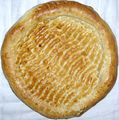 | |
| Type | Tandoor bread |
|---|---|
| Place of origin | |
Tandyr nan is a type of Central Asian bread [1] [2] cooked in a vertical clay oven, the tandyr or tandoor. It is circular and leavened with yeast, and typically has a crisp golden surface. They are often decorated by stamping patterns on the dough, and can be topped with ingredients like sesame seeds, nigella seeds, or thinly sliced onion. [3]









